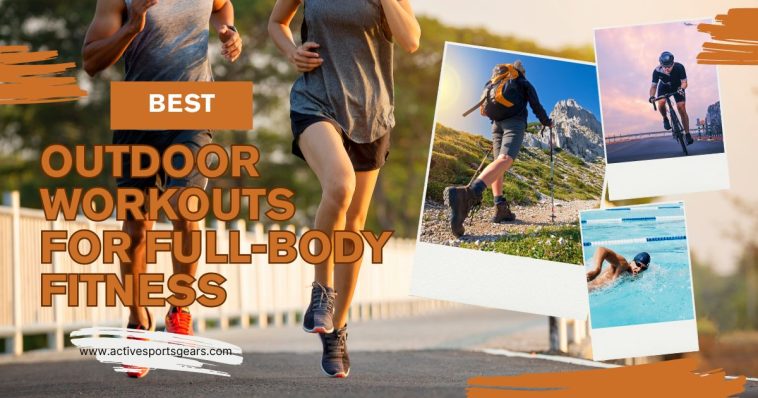Exercising outdoors offers more than just physical benefits. Fresh air, sunlight, and the natural environment stimulate both the body and mind. Outdoor workouts can boost your mood, reduce stress, and improve overall fitness, all while allowing you to engage with nature. Full-body conditioning involves training multiple muscle groups simultaneously, thereby enhancing strength, endurance, flexibility, and balance.
Whether you are a beginner or an experienced athlete, incorporating outdoor workouts into your routine can be a transformative experience. The right combination of exercises can strengthen your core, tone muscles, improve cardiovascular health, and elevate your stamina. In this guide, we explore 20 of the best outdoor workouts for full-body conditioning, providing practical instructions, variations, and tips to make the most of your outdoor sessions.
20 Best Outdoor Workouts
1. Running or Jogging
Running is a classic outdoor workout that engages the legs, core, and cardiovascular system. Trail running or jogging on uneven surfaces also challenges stabilizing muscles and balance.
- Tips: Use proper running shoes to reduce joint strain. Maintain an upright posture and engage your core.
- Variation: Sprint intervals on a track or hill sprints for explosive strength and endurance.
Running improves leg strength, boosts heart health, and burns calories efficiently.
2. Cycling
Cycling strengthens the lower body, improves cardiovascular fitness, and can be a low-impact option for people with joint issues.
- Tips: Adjust the seat for proper alignment and pedal with a smooth motion.
- Variation: Include hill climbs or interval sprints for added resistance and calorie burn.
A scenic outdoor bike ride can be both exhilarating and an effective full-body workout when combined with core engagement during riding.
3. Hiking
Hiking is a functional workout that builds strength, endurance, and balance. The uneven terrain engages the core, glutes, and leg muscles.
- Tips: Start with shorter trails and gradually increase the distance over time. Wear supportive hiking shoes.
- Variation: Use trekking poles to incorporate upper body muscles and enhance stability.
Hiking also improves mental focus and connects you with nature, making it a holistic form of exercise.
4. Swimming in Open Water
Swimming is a full-body exercise that targets the arms, shoulders, core, and legs. Open-water swimming offers natural resistance and engages the stabilizing muscles more than pool swimming.
- Tips: Use proper technique to avoid shoulder strain. Swim in safe, designated areas.
- Variation: Mix strokes, such as freestyle, breaststroke, and backstroke, to work different muscle groups.
Swimming improves cardiovascular health and builds lean muscle while being easy on the joints.
5. Bodyweight Circuit Training
Bodyweight exercises are versatile and require no equipment, making them perfect for parks, beaches, or backyards. A circuit might include exercises such as push-ups, squats, lunges, planks, and burpees.
- Tips: Perform each exercise for 30 to 60 seconds, resting briefly between moves.
- Variation: Increase intensity by adding jump squats, mountain climbers, or plyometric push-ups.
Circuit training combines strength training and cardiovascular exercise, maximizing calorie burn and improving overall conditioning.
6. Resistance Band Workouts
Resistance bands are portable and effective for outdoor strength training. They target all major muscle groups, including the arms, chest, back, and legs.
- Tips: Secure bands to a sturdy tree or pole for rows, presses, or pull-aparts.
- Variation: Combine bands with squats or lunges for compound movements that engage multiple muscles.
Bands are ideal for full-body conditioning and can be easily adapted for beginners or advanced users.
7. Rowing
Rowing on water engages the back, arms, legs, and core, providing an effective low-impact workout.
- Tips: Maintain a straight back and avoid hunching. Use controlled strokes for efficiency.
- Variation: Alternate between steady-state and high-intensity intervals to improve cardiovascular endurance.
Rowing strengthens the upper and lower body simultaneously while promoting endurance and coordination.
8. Sand or Beach Workouts
Beach workouts increase resistance due to the soft, uneven surface, which challenges stabilizing muscles and improves balance. Exercises can include running, jumping, push-ups, and lunges.
- Tips: Start with shorter sessions to adapt to the challenging terrain.
- Variation: Add sandbag exercises for additional resistance and full-body engagement.
These workouts boost strength, agility, and cardiovascular fitness while being fun and scenic.
9. Kayaking or Canoeing
Paddling sports offer an excellent upper-body and core workout. The repetitive motion strengthens the arms, shoulders, and back, while engaging the abs.
- Tips: Maintain proper posture and engage the core to protect your lower back.
- Variation: Combine with interval paddling to improve endurance and strength.
Kayaking is a low-impact, enjoyable activity that simultaneously strengthens the upper body and core.
10. Outdoor Bootcamp Classes
Bootcamp workouts combine cardio, strength, and functional exercises, often led by a trainer in parks or outdoor spaces. Exercises include running, push-ups, burpees, squats, and agility drills.
- Tips: Start with beginner classes to learn proper form.
- Variation: Include partner exercises for added motivation and engagement.
Bootcamp workouts are high-intensity, effective, and ideal for full-body conditioning while enjoying a group environment.
11. Rock Climbing
Outdoor rock climbing targets the upper body, core, and legs while improving balance and coordination.
- Tips: Learn proper safety techniques and use harnesses and climbing shoes.
- Variation: Bouldering offers challenging climbs without ropes for short, intense sessions.
Climbing develops strength, endurance, and mental focus, making it one of the most comprehensive full-body workouts.
12. Jump Rope
Jump rope is a simple, portable, and highly effective cardio exercise. It engages the legs, core, shoulders, and arms, improving coordination and agility.
- Tips: Use proper technique, keeping elbows close to the body and jumping lightly.
- Variation: Mix in high knees or double-unders for increased intensity.
Jumping rope burns calories quickly, strengthens the lower body, and boosts cardiovascular health.
13. Outdoor Yoga and Pilates
Yoga and Pilates in parks or on beaches enhance flexibility, core strength, and balance. Outdoor sessions incorporate natural resistance, such as uneven surfaces, and engage the stabilizing muscles to enhance overall stability.
- Tips: Bring a mat, towel, or yoga blocks for comfort and alignment.
- Variation: Combine dynamic Pilates exercises with yoga flows for a full-body conditioning experience.
Practicing outdoors connects the mind, body, and nature while building strength and flexibility.
14. Stair Climbing
Stair workouts strengthen the glutes, quadriceps, hamstrings, and calves. They also improve cardiovascular endurance.
- Tips: Start slowly to adapt to intensity and protect the knees.
- Variation: Carry light weights or perform step-ups with knee lifts for added resistance.
Stair climbing is an effective, accessible, and great way to combine cardio and strength training outdoors.
15. Trail Sprints
Trail sprints challenge the legs, core, and cardiovascular system while engaging stabilizing muscles due to uneven terrain.
- Tips: Choose safe trails and perform proper warm-ups to avoid injury.
- Variation: Mix uphill sprints with recovery jogs for interval training.
This workout builds explosive power, endurance, and agility while keeping outdoor sessions exciting.
16. Bodyweight HIIT Outdoors
High-intensity interval training (HIIT) involves alternating short bursts of intense exercise with brief rest periods. Exercises like push-ups, lunges, burpees, and planks provide full-body conditioning.
- Tips: Focus on form to prevent injury. Adapt intensity based on fitness level.
- Variation: Use natural elements, such as park benches or tree branches, for pull-ups or dips.
HIIT outdoors boosts metabolism, burns fat, and strengthens muscles efficiently.
17. Resistance Sled Pushes or Tire Flips
Using heavy objects, such as tires or sleds, can transform outdoor workouts. These functional movements strengthen the legs, back, core, and arms, providing a comprehensive workout for the entire body.
- Tips: Maintain proper posture and use controlled movements.
- Variation: Combine with running or sprint intervals for a full-body conditioning workout.
Functional strength exercises simulate real-life movements and build power and endurance.
18. Outdoor Circuit Training
Circuit training in an open space allows for the combination of strength, cardio, and agility. Exercises include running, push-ups, squats, burpees, planks, and box jumps.
- Tips: Set up stations using natural features or portable equipment.
- Variation: Add resistance bands, kettlebells, or sandbags for additional challenge.
Outdoor circuits are engaging, flexible, and ideal for group sessions or solo workouts.
19. Functional Fitness Trails
Some parks offer fitness trails with pull-up bars, balance beams, and parallel bars. These provide natural stations for full-body workouts.
- Tips: Incorporate a mix of bodyweight exercises, such as dips, pull-ups, and step-ups, to maximize your workout.
- Variation: Incorporate sprints or jump squats between stations for cardio.
These trails combine strength, endurance, and agility training while making workouts dynamic and enjoyable.
20. Paddleboarding
Stand-up paddleboarding engages the core, legs, arms, and back while improving balance. It is also a low-impact cardio exercise.
- Tips: Start on calm water to build balance and confidence.
- Variation: Incorporate squats or kneeling paddle positions to target different muscle groups.
Paddleboarding is both relaxing and challenging, making it a perfect outdoor full-body conditioning workout.
Tips for Maximizing Outdoor Workouts
- Warm-Up Properly: Begin with dynamic stretches or light jogging to prevent injuries.
- Stay Hydrated: Bring water to maintain energy and prevent dehydration.
- Use Sun Protection: Apply sunscreen, wear sunglasses, and consider wearing a hat to protect your skin.
- Adapt to Weather: Layer your clothing in cooler weather and opt for breathable fabrics in warmer weather.
- Listen to Your Body: Outdoor workouts can be intense. Rest when necessary to avoid overtraining.
Outdoor workouts provide an excellent way to achieve full-body conditioning while connecting with nature. From running and cycling to paddleboarding and bodyweight circuits, the variety of exercises ensures every muscle group is engaged. Outdoor fitness not only builds strength, endurance, and flexibility but also promotes mental well-being, motivation, and enjoyment.
Incorporating these 20 workouts into your routine allows you to take advantage of fresh air, natural landscapes, and dynamic environments. Whether you are training solo, with friends, or in a structured class, these exercises offer endless opportunities to challenge yourself, explore new locations, and maintain a healthy, balanced lifestyle. By embracing outdoor full-body workouts, you can achieve peak physical condition while enjoying the beauty and benefits of the natural world.



